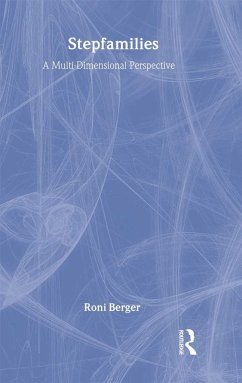- Gebundenes Buch
- Merkliste
- Auf die Merkliste
- Bewerten Bewerten
- Teilen
- Produkt teilen
- Produkterinnerung
- Produkterinnerung
Combining theoretical, empirical, and clinical knowledge, Stepfamilies: A Multi-Dimensional Perspective contains recent research and information that will help mental health practitioners, family therapists, psychologists, and counselors understand the characteristics, dynamics, needs, and issues of nonclinical stepfamilies. Based on direct experiences with diverse types of stepfamilies, this book gives you new guidelines and strategies that will enable you to offer more successful sessions to your clients and improve your effectiveness as a practitioner.
Andere Kunden interessierten sich auch für
![What Works in Stepfamilies What Works in Stepfamilies]() Lawrence GanongWhat Works in Stepfamilies166,99 €
Lawrence GanongWhat Works in Stepfamilies166,99 €![Stepfamilies Stepfamilies]() Marvin B SussmanStepfamilies115,99 €
Marvin B SussmanStepfamilies115,99 €![China's One-Child Policy and Multiple Caregiving China's One-Child Policy and Multiple Caregiving]() Esther GohChina's One-Child Policy and Multiple Caregiving131,99 €
Esther GohChina's One-Child Policy and Multiple Caregiving131,99 €![The Modern Clinician's Guide to Working with LGBTQ+ Clients The Modern Clinician's Guide to Working with LGBTQ+ Clients]() Margaret NicholsThe Modern Clinician's Guide to Working with LGBTQ+ Clients170,99 €
Margaret NicholsThe Modern Clinician's Guide to Working with LGBTQ+ Clients170,99 €![Family and School Family and School]() Daphne JohnsonFamily and School115,99 €
Daphne JohnsonFamily and School115,99 €![Advances and Techniques in Restoration Therapy Advances and Techniques in Restoration Therapy]() Terry D HargraveAdvances and Techniques in Restoration Therapy150,99 €
Terry D HargraveAdvances and Techniques in Restoration Therapy150,99 €![African-American Adolescents in the Urban Community African-American Adolescents in the Urban Community]() Judith Rozie-BattleAfrican-American Adolescents in the Urban Community170,99 €
Judith Rozie-BattleAfrican-American Adolescents in the Urban Community170,99 €-
-
-
Combining theoretical, empirical, and clinical knowledge, Stepfamilies: A Multi-Dimensional Perspective contains recent research and information that will help mental health practitioners, family therapists, psychologists, and counselors understand the characteristics, dynamics, needs, and issues of nonclinical stepfamilies. Based on direct experiences with diverse types of stepfamilies, this book gives you new guidelines and strategies that will enable you to offer more successful sessions to your clients and improve your effectiveness as a practitioner.
Hinweis: Dieser Artikel kann nur an eine deutsche Lieferadresse ausgeliefert werden.
Hinweis: Dieser Artikel kann nur an eine deutsche Lieferadresse ausgeliefert werden.
Produktdetails
- Produktdetails
- Verlag: Taylor & Francis
- Seitenzahl: 272
- Erscheinungstermin: 7. Oktober 1998
- Englisch
- Abmessung: 229mm x 152mm x 16mm
- Gewicht: 535g
- ISBN-13: 9780789002808
- ISBN-10: 0789002809
- Artikelnr.: 21517302
- Herstellerkennzeichnung
- Libri GmbH
- Europaallee 1
- 36244 Bad Hersfeld
- gpsr@libri.de
- Verlag: Taylor & Francis
- Seitenzahl: 272
- Erscheinungstermin: 7. Oktober 1998
- Englisch
- Abmessung: 229mm x 152mm x 16mm
- Gewicht: 535g
- ISBN-13: 9780789002808
- ISBN-10: 0789002809
- Artikelnr.: 21517302
- Herstellerkennzeichnung
- Libri GmbH
- Europaallee 1
- 36244 Bad Hersfeld
- gpsr@libri.de
Roni Berger, PhD, CSW, is Assistant Professor at the Adeiphi University School of Social Work in Garden City, Long Island. She is also the Supervisor of Group Work in the Russian Adolescent Program of JBFC'S. Dr. Berger serves on the Advisory Boards of International Conferences of Family Therapy and is a member of the Association for the Advancement of Social Work with Groups, the Council on Social Work Education, and he Adelphi University Senate. She is the author or co-author of five books, numerous journal articles, and has spoken at several conferences on social work with families and with groups. Her current research interests include cross-cultural aspects of stepfamilies, immigrant stepfamilies, and adolescent immigrants.
Contents
Acknowledgments
* Foreword
* Part I: The Nature and History of Stepfamilies
* Introduction: The Changing Context of Stepfamilies
* Chapter 1. Introduction: The Changing Context of Stepfamilies
* Chapter 2. Stepfamilies: Who Are They?
* What Is a Stepfamily? How Many Stepfamilies Are There?
* A Short History of Stepfamilies
* What Do We Know About Stepfamilies? A Critical Review of Empirical
and Clinical Knowledge
* Summary
* Chapter 3. Characteristic Features of Stepfamilies
* Structural Characteristics of Stepfamilies
* Dynamic Characteristics of Stepfamilies
* Developmental Characteristics of Stepfamilies
* Summary
* Chapter 4. Key Issues of Stepfamilies
* Past Orientation: The Attitude of the Stepfamily Toward the Past
* Acceptance/Rejection of Difference: The Self-Perception of the Family
vis-à-vis Other Types of Families
* The Dominant Substructure of the Family: The Focal Subsystem
* Summary
* Part II: Types of Stepfamilies--An Innovative Classification
* Chapter 5. Integrated Families: Combining Then and Now Around the
Couple
* Profile of Integrated Stepfamilies
* Combining Past and Present
* Acknowledging Differences
* Marital Focal Subsystem
* Characteristics of the Integrated Nature of the Family
* Typical Issues
* Case Illustration: The Everest Family
* Summary
* Chapter 6. Invented Stepfamilies: The Time Is Now and the Family Is
the Focus
* Profile of Invented Stepfamilies
* Discarding the Past: The TIme Is Now
* Denial of Differences: We Are A Regular Family
* A Parental Focal Subsystem
* Main Issues: Invented Families--Whose Invention?
* Case Illustration: The Fox Family
* Summary
* Chapter 7. Imported Stepfamilies: Living the "There and Then" in the
"Here and Now"
* Profile of Imported Stepfamilies
* Reliving the Past in the Present
* Denying Differences from Non-Stepfamilies
* Marital Focal Subsystem
* Case Illustration: The Duncan Family
* Summary
* Part Three: Stepfamilies and Culture
* Chapter 8. Immigrant Stepfamilies
* The Experience of Multiple Losses
* Phases in the Immigration Process
* Paths to Becoming an Immigrant Stepfamily
* Combined Effects of Immigration and Stepfamily
* Case Illustration: The Kovarsky Family
* Summary
* Black Stepfamilies
* The History of the Black Stepfamily
* A Black Communal-Oriented Philosophy
* Permeability of Boundaries in Black Families
* Informal Adoption Among Black Families
* Role Flexibility of Black Families
* Living with the Experience of Being Different
* Case Illustration: The Wilson Family
* Summary
* Chapter 10. Gay and Lesbian Stepfamilies
* Triple Stigmatization of Gay Stepfamilies
* Typical Issues of Gay and Lesbian Stepfamilies
* Case Illustration: The Roth-Johnston Family
* Part Four: Helping Stepfamilies of Diverse Types--Implications for
Practice
* Chapter 11. Assessing Stepfamilies
* Differential Evaluation of Normative Stepfamily Issues versus
Dysfunctional Patterns
* Differential Assessment of Diverse Types of Stepfamilies
* Methods of Assessing Stepfamilies: Interviews, Genograms, and
Standardized Instruments
* Summary
* Chapter 12. Partners and Focus: Choosing with Whom to Work on Which
Issues
* Deciding with Whom to Work
* Deciding What to Work On
* Summary
* Chapter 13. Strategies and Techniques for Working with Stepfamilies
* Normalizing the Stepfamily Experience
* Providing Psychoeducation
* Negotiating Flexibility and Promoting Creativity
* Using Collaborative Conversational Approaches
* Summary
* Chapter 14. Changing Social Context: Working on Behalf of
Stepfamilies
* Developing a Step-Relationships Language
* Challenging the Brady Bunch Stereotype: Developing Realistic
Recognition of Stepfamilies, Their Uniqueness, and Diversity
* Developing Specific Servic
Acknowledgments
* Foreword
* Part I: The Nature and History of Stepfamilies
* Introduction: The Changing Context of Stepfamilies
* Chapter 1. Introduction: The Changing Context of Stepfamilies
* Chapter 2. Stepfamilies: Who Are They?
* What Is a Stepfamily? How Many Stepfamilies Are There?
* A Short History of Stepfamilies
* What Do We Know About Stepfamilies? A Critical Review of Empirical
and Clinical Knowledge
* Summary
* Chapter 3. Characteristic Features of Stepfamilies
* Structural Characteristics of Stepfamilies
* Dynamic Characteristics of Stepfamilies
* Developmental Characteristics of Stepfamilies
* Summary
* Chapter 4. Key Issues of Stepfamilies
* Past Orientation: The Attitude of the Stepfamily Toward the Past
* Acceptance/Rejection of Difference: The Self-Perception of the Family
vis-à-vis Other Types of Families
* The Dominant Substructure of the Family: The Focal Subsystem
* Summary
* Part II: Types of Stepfamilies--An Innovative Classification
* Chapter 5. Integrated Families: Combining Then and Now Around the
Couple
* Profile of Integrated Stepfamilies
* Combining Past and Present
* Acknowledging Differences
* Marital Focal Subsystem
* Characteristics of the Integrated Nature of the Family
* Typical Issues
* Case Illustration: The Everest Family
* Summary
* Chapter 6. Invented Stepfamilies: The Time Is Now and the Family Is
the Focus
* Profile of Invented Stepfamilies
* Discarding the Past: The TIme Is Now
* Denial of Differences: We Are A Regular Family
* A Parental Focal Subsystem
* Main Issues: Invented Families--Whose Invention?
* Case Illustration: The Fox Family
* Summary
* Chapter 7. Imported Stepfamilies: Living the "There and Then" in the
"Here and Now"
* Profile of Imported Stepfamilies
* Reliving the Past in the Present
* Denying Differences from Non-Stepfamilies
* Marital Focal Subsystem
* Case Illustration: The Duncan Family
* Summary
* Part Three: Stepfamilies and Culture
* Chapter 8. Immigrant Stepfamilies
* The Experience of Multiple Losses
* Phases in the Immigration Process
* Paths to Becoming an Immigrant Stepfamily
* Combined Effects of Immigration and Stepfamily
* Case Illustration: The Kovarsky Family
* Summary
* Black Stepfamilies
* The History of the Black Stepfamily
* A Black Communal-Oriented Philosophy
* Permeability of Boundaries in Black Families
* Informal Adoption Among Black Families
* Role Flexibility of Black Families
* Living with the Experience of Being Different
* Case Illustration: The Wilson Family
* Summary
* Chapter 10. Gay and Lesbian Stepfamilies
* Triple Stigmatization of Gay Stepfamilies
* Typical Issues of Gay and Lesbian Stepfamilies
* Case Illustration: The Roth-Johnston Family
* Part Four: Helping Stepfamilies of Diverse Types--Implications for
Practice
* Chapter 11. Assessing Stepfamilies
* Differential Evaluation of Normative Stepfamily Issues versus
Dysfunctional Patterns
* Differential Assessment of Diverse Types of Stepfamilies
* Methods of Assessing Stepfamilies: Interviews, Genograms, and
Standardized Instruments
* Summary
* Chapter 12. Partners and Focus: Choosing with Whom to Work on Which
Issues
* Deciding with Whom to Work
* Deciding What to Work On
* Summary
* Chapter 13. Strategies and Techniques for Working with Stepfamilies
* Normalizing the Stepfamily Experience
* Providing Psychoeducation
* Negotiating Flexibility and Promoting Creativity
* Using Collaborative Conversational Approaches
* Summary
* Chapter 14. Changing Social Context: Working on Behalf of
Stepfamilies
* Developing a Step-Relationships Language
* Challenging the Brady Bunch Stereotype: Developing Realistic
Recognition of Stepfamilies, Their Uniqueness, and Diversity
* Developing Specific Servic
Contents
Acknowledgments
* Foreword
* Part I: The Nature and History of Stepfamilies
* Introduction: The Changing Context of Stepfamilies
* Chapter 1. Introduction: The Changing Context of Stepfamilies
* Chapter 2. Stepfamilies: Who Are They?
* What Is a Stepfamily? How Many Stepfamilies Are There?
* A Short History of Stepfamilies
* What Do We Know About Stepfamilies? A Critical Review of Empirical
and Clinical Knowledge
* Summary
* Chapter 3. Characteristic Features of Stepfamilies
* Structural Characteristics of Stepfamilies
* Dynamic Characteristics of Stepfamilies
* Developmental Characteristics of Stepfamilies
* Summary
* Chapter 4. Key Issues of Stepfamilies
* Past Orientation: The Attitude of the Stepfamily Toward the Past
* Acceptance/Rejection of Difference: The Self-Perception of the Family
vis-à-vis Other Types of Families
* The Dominant Substructure of the Family: The Focal Subsystem
* Summary
* Part II: Types of Stepfamilies--An Innovative Classification
* Chapter 5. Integrated Families: Combining Then and Now Around the
Couple
* Profile of Integrated Stepfamilies
* Combining Past and Present
* Acknowledging Differences
* Marital Focal Subsystem
* Characteristics of the Integrated Nature of the Family
* Typical Issues
* Case Illustration: The Everest Family
* Summary
* Chapter 6. Invented Stepfamilies: The Time Is Now and the Family Is
the Focus
* Profile of Invented Stepfamilies
* Discarding the Past: The TIme Is Now
* Denial of Differences: We Are A Regular Family
* A Parental Focal Subsystem
* Main Issues: Invented Families--Whose Invention?
* Case Illustration: The Fox Family
* Summary
* Chapter 7. Imported Stepfamilies: Living the "There and Then" in the
"Here and Now"
* Profile of Imported Stepfamilies
* Reliving the Past in the Present
* Denying Differences from Non-Stepfamilies
* Marital Focal Subsystem
* Case Illustration: The Duncan Family
* Summary
* Part Three: Stepfamilies and Culture
* Chapter 8. Immigrant Stepfamilies
* The Experience of Multiple Losses
* Phases in the Immigration Process
* Paths to Becoming an Immigrant Stepfamily
* Combined Effects of Immigration and Stepfamily
* Case Illustration: The Kovarsky Family
* Summary
* Black Stepfamilies
* The History of the Black Stepfamily
* A Black Communal-Oriented Philosophy
* Permeability of Boundaries in Black Families
* Informal Adoption Among Black Families
* Role Flexibility of Black Families
* Living with the Experience of Being Different
* Case Illustration: The Wilson Family
* Summary
* Chapter 10. Gay and Lesbian Stepfamilies
* Triple Stigmatization of Gay Stepfamilies
* Typical Issues of Gay and Lesbian Stepfamilies
* Case Illustration: The Roth-Johnston Family
* Part Four: Helping Stepfamilies of Diverse Types--Implications for
Practice
* Chapter 11. Assessing Stepfamilies
* Differential Evaluation of Normative Stepfamily Issues versus
Dysfunctional Patterns
* Differential Assessment of Diverse Types of Stepfamilies
* Methods of Assessing Stepfamilies: Interviews, Genograms, and
Standardized Instruments
* Summary
* Chapter 12. Partners and Focus: Choosing with Whom to Work on Which
Issues
* Deciding with Whom to Work
* Deciding What to Work On
* Summary
* Chapter 13. Strategies and Techniques for Working with Stepfamilies
* Normalizing the Stepfamily Experience
* Providing Psychoeducation
* Negotiating Flexibility and Promoting Creativity
* Using Collaborative Conversational Approaches
* Summary
* Chapter 14. Changing Social Context: Working on Behalf of
Stepfamilies
* Developing a Step-Relationships Language
* Challenging the Brady Bunch Stereotype: Developing Realistic
Recognition of Stepfamilies, Their Uniqueness, and Diversity
* Developing Specific Servic
Acknowledgments
* Foreword
* Part I: The Nature and History of Stepfamilies
* Introduction: The Changing Context of Stepfamilies
* Chapter 1. Introduction: The Changing Context of Stepfamilies
* Chapter 2. Stepfamilies: Who Are They?
* What Is a Stepfamily? How Many Stepfamilies Are There?
* A Short History of Stepfamilies
* What Do We Know About Stepfamilies? A Critical Review of Empirical
and Clinical Knowledge
* Summary
* Chapter 3. Characteristic Features of Stepfamilies
* Structural Characteristics of Stepfamilies
* Dynamic Characteristics of Stepfamilies
* Developmental Characteristics of Stepfamilies
* Summary
* Chapter 4. Key Issues of Stepfamilies
* Past Orientation: The Attitude of the Stepfamily Toward the Past
* Acceptance/Rejection of Difference: The Self-Perception of the Family
vis-à-vis Other Types of Families
* The Dominant Substructure of the Family: The Focal Subsystem
* Summary
* Part II: Types of Stepfamilies--An Innovative Classification
* Chapter 5. Integrated Families: Combining Then and Now Around the
Couple
* Profile of Integrated Stepfamilies
* Combining Past and Present
* Acknowledging Differences
* Marital Focal Subsystem
* Characteristics of the Integrated Nature of the Family
* Typical Issues
* Case Illustration: The Everest Family
* Summary
* Chapter 6. Invented Stepfamilies: The Time Is Now and the Family Is
the Focus
* Profile of Invented Stepfamilies
* Discarding the Past: The TIme Is Now
* Denial of Differences: We Are A Regular Family
* A Parental Focal Subsystem
* Main Issues: Invented Families--Whose Invention?
* Case Illustration: The Fox Family
* Summary
* Chapter 7. Imported Stepfamilies: Living the "There and Then" in the
"Here and Now"
* Profile of Imported Stepfamilies
* Reliving the Past in the Present
* Denying Differences from Non-Stepfamilies
* Marital Focal Subsystem
* Case Illustration: The Duncan Family
* Summary
* Part Three: Stepfamilies and Culture
* Chapter 8. Immigrant Stepfamilies
* The Experience of Multiple Losses
* Phases in the Immigration Process
* Paths to Becoming an Immigrant Stepfamily
* Combined Effects of Immigration and Stepfamily
* Case Illustration: The Kovarsky Family
* Summary
* Black Stepfamilies
* The History of the Black Stepfamily
* A Black Communal-Oriented Philosophy
* Permeability of Boundaries in Black Families
* Informal Adoption Among Black Families
* Role Flexibility of Black Families
* Living with the Experience of Being Different
* Case Illustration: The Wilson Family
* Summary
* Chapter 10. Gay and Lesbian Stepfamilies
* Triple Stigmatization of Gay Stepfamilies
* Typical Issues of Gay and Lesbian Stepfamilies
* Case Illustration: The Roth-Johnston Family
* Part Four: Helping Stepfamilies of Diverse Types--Implications for
Practice
* Chapter 11. Assessing Stepfamilies
* Differential Evaluation of Normative Stepfamily Issues versus
Dysfunctional Patterns
* Differential Assessment of Diverse Types of Stepfamilies
* Methods of Assessing Stepfamilies: Interviews, Genograms, and
Standardized Instruments
* Summary
* Chapter 12. Partners and Focus: Choosing with Whom to Work on Which
Issues
* Deciding with Whom to Work
* Deciding What to Work On
* Summary
* Chapter 13. Strategies and Techniques for Working with Stepfamilies
* Normalizing the Stepfamily Experience
* Providing Psychoeducation
* Negotiating Flexibility and Promoting Creativity
* Using Collaborative Conversational Approaches
* Summary
* Chapter 14. Changing Social Context: Working on Behalf of
Stepfamilies
* Developing a Step-Relationships Language
* Challenging the Brady Bunch Stereotype: Developing Realistic
Recognition of Stepfamilies, Their Uniqueness, and Diversity
* Developing Specific Servic








